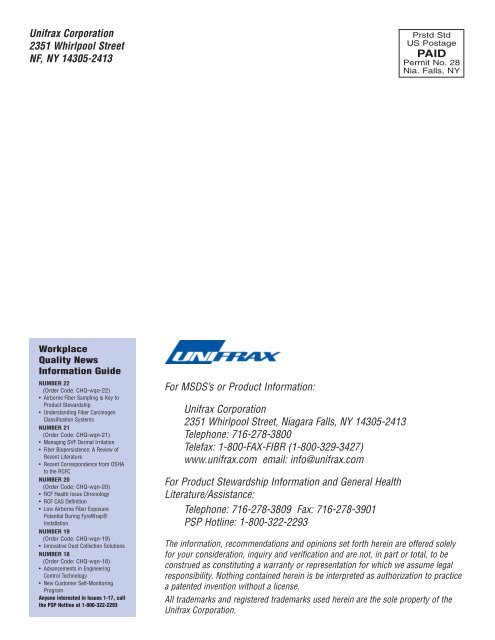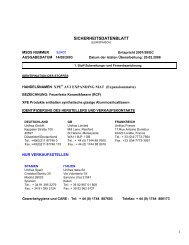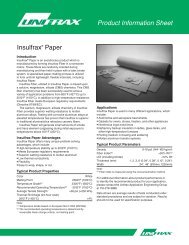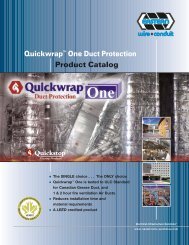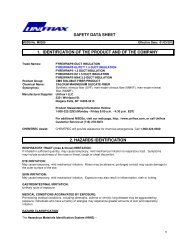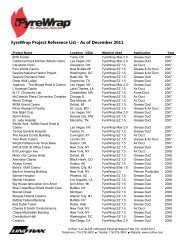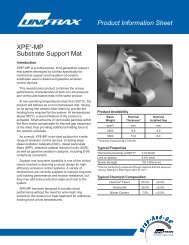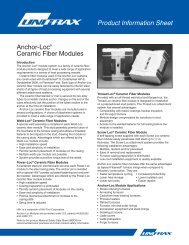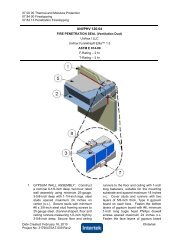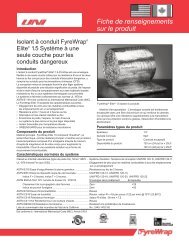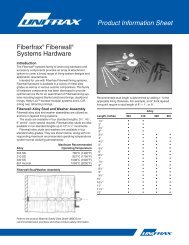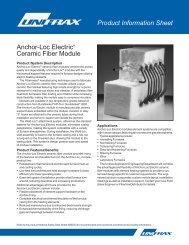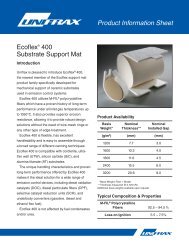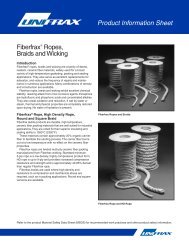Workplace Quality News - Unifrax
Workplace Quality News - Unifrax
Workplace Quality News - Unifrax
Create successful ePaper yourself
Turn your PDF publications into a flip-book with our unique Google optimized e-Paper software.
<strong>Unifrax</strong> Corporation<br />
2351 Whirlpool Street<br />
NF, NY 14305-2413<br />
Prstd Std<br />
US Postage<br />
PAID<br />
Permit No. 28<br />
Nia. Falls, NY<br />
<strong>Workplace</strong><br />
<strong>Quality</strong> <strong>News</strong><br />
Information Guide<br />
NUMBER 22<br />
(Order Code: CHQ-wqn-22)<br />
• Airborne Fiber Sampling is Key to<br />
Product Stewardship<br />
• Understanding Fiber Carcinogen<br />
Classification Systems<br />
NUMBER 21<br />
(Order Code: CHQ-wqn-21)<br />
• Managing SVF Dermal Irritation<br />
• Fiber Biopersistence: A Review of<br />
Recent Literature<br />
• Recent Correspondence from OSHA<br />
to the RCFC<br />
NUMBER 20<br />
(Order Code: CHQ-wqn-20)<br />
• RCF Health Issue Chronology<br />
• RCF CAS Definition<br />
• Low Airborne Fiber Exposure<br />
Potential During FyreWrap®<br />
Installation<br />
NUMBER 19<br />
(Order Code: CHQ-wqn-19)<br />
• Innovative Dust Collection Solutions<br />
NUMBER 18<br />
(Order Code: CHQ-wqn-18)<br />
• Advancements in Engineering<br />
Control Technology<br />
• New Customer Self-Monitoring<br />
Program<br />
Anyone interested in Issues 1-17, call<br />
the PSP Hotline at 1-800-322-2293<br />
For MSDS’s or Product Information:<br />
<strong>Unifrax</strong> Corporation<br />
2351 Whirlpool Street, Niagara Falls, NY 14305-2413<br />
Telephone: 716-278-3800<br />
Telefax: 1-800-FAX-FIBR (1-800-329-3427)<br />
www.unifrax.com email: info@unifrax.com<br />
For Product Stewardship Information and General Health<br />
Literature/Assistance:<br />
Telephone: 716-278-3809 Fax: 716-278-3901<br />
PSP Hotline: 1-800-322-2293<br />
The information, recommendations and opinions set forth herein are offered solely<br />
for your consideration, inquiry and verification and are not, in part or total, to be<br />
construed as constituting a warranty or representation for which we assume legal<br />
responsibility. Nothing contained herein is be interpreted as authorization to practice<br />
a patented invention without a license.<br />
All trademarks and registered trademarks used herein are the sole property of the<br />
<strong>Unifrax</strong> Corporation.
<strong>Workplace</strong> <strong>Quality</strong> <strong>News</strong><br />
Airborne Fiber Sampling is Key<br />
to Product Stewardship<br />
By Patrick Snodgrass, CSP, Sr. Health and Safety Specialist<br />
Number 22, August 2005<br />
<strong>Unifrax</strong> has always been proactive when it comes to the health and<br />
safety issues associated with refractory ceramic fiber (RCF) by promoting<br />
the <strong>Unifrax</strong> Product Stewardship Program. This program<br />
builds its success from airborne fiber sampling not only at <strong>Unifrax</strong><br />
facilities, but at customer facilities as well. This complementary service<br />
provides customers with sampling results, which will in turn help<br />
them make decisions on either controlling or reducing airborne RCF.<br />
<strong>Workplace</strong> airborne fiber sampling is one of seven key elements that<br />
comprise the product stewardship program. The other elements<br />
include: communications, special studies, product research, evaluation<br />
of workplace controls, exposure assessments and health effects<br />
research.<br />
The product stewardship program is promoted by the three leading<br />
North American manufacturers of RCF: <strong>Unifrax</strong>, Thermal Ceramics and<br />
Vesuvius, which comprise the Refractory Ceramic Fibers Coalition<br />
(RCFC). These companies work together with support from the United<br />
States Occupational Safety and Health Administration (OSHA) to assist<br />
end users of RCF on the proper management of this fiber. As part of<br />
an agreement with the RCFC and OSHA, <strong>Unifrax</strong> actively pursues airborne<br />
fiber sampling and collects over one hundred samples at<br />
customer facilities each year.<br />
<strong>Unifrax</strong> has a staff of qualified industrial hygienists who specialize in<br />
airborne fiber sampling and engineering control evaluation. These<br />
hygienists have traveled throughout North America sampling and<br />
assisting users of RCF with engineering and administrative controls<br />
for reducing airborne RCF.<br />
Sampling at customer facilities typically involves employees who are<br />
engaged in full-shift, workplace exposure to ceramic fiber. These jobs<br />
can be found in automotive catalytic converter applications, vacuumforming<br />
operations, assembly of products with RCF and finishing<br />
RCF-containing products by either cutting, sanding or drilling.<br />
However, sampling is also conducted on employees involved in shortterm<br />
exposure jobs when installing or removing RCF used in<br />
furnacing applications. Many samples are also collected for tasks<br />
that may have passive RCF exposure such as maintenance, material<br />
handlers and fork truck operators.<br />
Once sampling has been conducted at a facility, the hygienist will<br />
submit the samples to an independent laboratory for analysis. Upon<br />
completion of the analysis, a report will be generated and sent to the<br />
customer, which will outline sample results and any recommendations<br />
on respirator use or engineering controls to reduce RCF<br />
exposure. <strong>Unifrax</strong> has also developed a self-monitoring program<br />
designed to assist customers in conducting their own industrial<br />
hygiene airborne fiber monitoring.<br />
If you are interested in learning more about the <strong>Unifrax</strong> Product<br />
Stewardship Program or would like to request a visit for<br />
airborne fiber sampling, please contact an industrial hygienist at<br />
1-800-322-2293.<br />
Exposure<br />
Assessments<br />
Study<br />
of <strong>Workplace</strong><br />
Controls<br />
Product<br />
Research<br />
Airborne<br />
Fiber<br />
Monitoring<br />
RCF Product<br />
Stewardship<br />
Program (PSP)<br />
Health Effects<br />
Research<br />
Special Studies<br />
Communications
Understanding Fiber Carcinogen<br />
Classification Systems<br />
By Russ Person, Risk Management Specialist and Julie Mayer, Health and Safety Engineer<br />
There are a number of scientific organizations and regulatory agencies that have developed systems for the identification and classification of carcinogenic<br />
materials. Mineral fibers and synthetic vitreous fibers have been the subject of reviews under many of these carcinogen classification systems.<br />
It is important to understand that while some substances (such as asbestos), are proven human carcinogens, evidence of human carcinogenicity is<br />
lacking in many of the substances evaluated. Often, in the absence of human data, researchers only have the results of animal testing on which to<br />
base their decisions. It is also important to understand that carcinogen classifications are based solely on hazard evaluations. In many cases, there<br />
may be little to no risk of producing cancer under normal usage conditions.<br />
TABLE 1: FIBER CARCINOGEN CLASSIFICATION SYSTEMS<br />
IARC NTP ACGIH EPA Cal. EU<br />
ASBESTOS 1 (1987) “Known” A1 A “known” Cat. 1<br />
MINERAL WOOL 3 (2001) Not Classified A3 (rock wool) None Not listed Cat. 3<br />
(rock / slag)<br />
2B (1987)<br />
FIBERGLASS 3 (2001) “Reasonably Anticipated” A3 None “known” Cat. 3<br />
2B (1987)<br />
SPECIAL PURPOSE 2B (2001) Not Classified A3 None “known” Cat. 2<br />
GLASS (E-GLASS, 475)<br />
SAFFIL 2B (1987) “Reasonably Anticipated” None None “known” Not<br />
Classified<br />
RCF 2B (2001) “Reasonably Anticipated” A2 B2 “known” Cat. 2<br />
2B (1987)<br />
IARC (INTERNATIONAL AGENCY FOR RESEARCH ON CANCER) http://www.iarc.fr<br />
Group 3: not classifiable as to carcinogenicity to humans, based on inadequate evidence of carcinogenicity in humans and inadequate or<br />
limited evidence in experimental animals<br />
Group 2B: possibly carcinogenic to humans, based on inadequate evidence of carcinogenicity in humans and sufficient evidence of carcinogenicity<br />
in experimental animals<br />
Group 1: carcinogenic to humans<br />
NTP (NATIONAL TOXICOLOGY PROGRAM) http://ntp-server.niehs.nih.gov/<br />
“Reasonably anticipated to be a human carcinogen” includes those substances in which there is sufficient evidence of carcinogenicity from studies in<br />
experimental animals. “Known to be a human carcinogen” includes substances for which there is sufficient evidence of carcinogenicity from studies in<br />
humans that indicates a causal relationship between exposure to the agent, substance, or mixture and human cancer.<br />
ACGIH (AMERICAN CONFERENCE OF GOVERNMENTAL INDUSTRIAL HYGIENISTS) http://www.acgih.org<br />
Group A3: confirmed animal carcinogen with unknown relevance to humans<br />
Group A2: suspected human carcinogen, based on limited evidence of carcinogenicity in humans and sufficient evidence of carcinogenicity in<br />
experimental animals with relevance to humans<br />
Group A1: confirmed human carcinogen<br />
EPA (ENVIRONMENTAL PROTECTION AGENCY) http://www.epa.gov<br />
Group B2: Probable human carcinogen, based on sufficient evidence of carcinogenicity in animals<br />
Group A: Carcinogenic to humans<br />
CALIFORNIA PROPOSITION 65 http://www.oehha.ca.gov/prop65.html<br />
“known to the state of California to cause cancer” — IARC “possibly carcinogenic” listing used as a criterion for inclusion.<br />
EUROPEAN UNION http://europa.eu.int/eur-lex/lex/en/index.htm<br />
Category 3: substances which cause concern for humans owing to possible carcinogenic effects, but in respect of which the available information<br />
is not adequate for making a satisfactory assessment. Commission Directive 97/69/EC contains two notes (Notes Q and R)<br />
which allow for exemption from category 3.<br />
Category 2: substances which should be regarded as if they were carcinogenic to humans<br />
Category 1: substances known to be carcinogenic to humans<br />
<strong>Workplace</strong> <strong>Quality</strong> <strong>News</strong> • Page 2
TABLE 2:<br />
IARC GROUP 1 SUBSTANCES<br />
CHEMICAL WHERE FOUND/COMMON USES COMMON NAMES<br />
Arsenic<br />
Benzene<br />
Ethylene Oxide<br />
Pressure Treated Wood<br />
Gasoline, Tobacco Smoke, Pesticides<br />
Production of Ethylene Glycol<br />
(Substance Found in Antifreeze)<br />
Formaldehyde Cosmetics, Antiseptics, Food Methylene Oxide, Methanal,<br />
Preservatives, Used in the Manufacture of<br />
Oxymethyline,<br />
Phenolic Resin<br />
Methylaldehyde, Oxomethane<br />
Nickel Compounds<br />
Jewelry, Coins, Stainless Steel<br />
Silica Beach Sand, Brick Making, Sandblasting, Crystalline Silica<br />
Enameling, Quarrying and Cutting of Rock<br />
Vinyl Chloride PVC, Pipes, Wire Coatings, Chloroethene, Chloroethylene,<br />
Packaging Materials<br />
Ethylene Mono-chloride<br />
TABLE 3:<br />
IARC GROUP 2B SUBSTANCES<br />
CHEMICAL WHERE FOUND/COMMON USES COMMON NAMES<br />
Carbon Black<br />
Rubber, Pigment, Paints, Inks,<br />
Natural Gas<br />
Dichloromethane Solvents, Paint Removers, Degreasers, Methylene Chloride<br />
Aerosol Products<br />
Ethylbenzene<br />
Lead<br />
Magnetic Fields<br />
Inks, Paints, Insecticides, Rubber<br />
and Plastic Production, Gasoline Production<br />
Batteries, Ammunition, Metal Products,<br />
Solder and Pipes, Devices to Shield X-Rays<br />
Power Lines (Extremely Low Frequency)<br />
Napthalene Moth Balls, Tobacco Smoke, Creosote White Tar, Tar Camphor<br />
Treatment in Wood<br />
Nickel, Metallic<br />
Dentistry<br />
Styrene Food Containers, Rubber, Plastic, Polystyrene<br />
Fiberglass, Pipes<br />
Tetrafluoroethylene Coating on Cookware, Stain Repellant Teflon®<br />
Vinyl Acetate<br />
Glues for Packaging and Building Industries,<br />
Paint, Textiles, Paper, Food Packaging,<br />
Modifier of Food Starch<br />
Carrageenan Food Stabilizer, Cosmetic industry Irish Moss, Red-Seaweed<br />
Page 3 • <strong>Workplace</strong> <strong>Quality</strong> <strong>News</strong>


